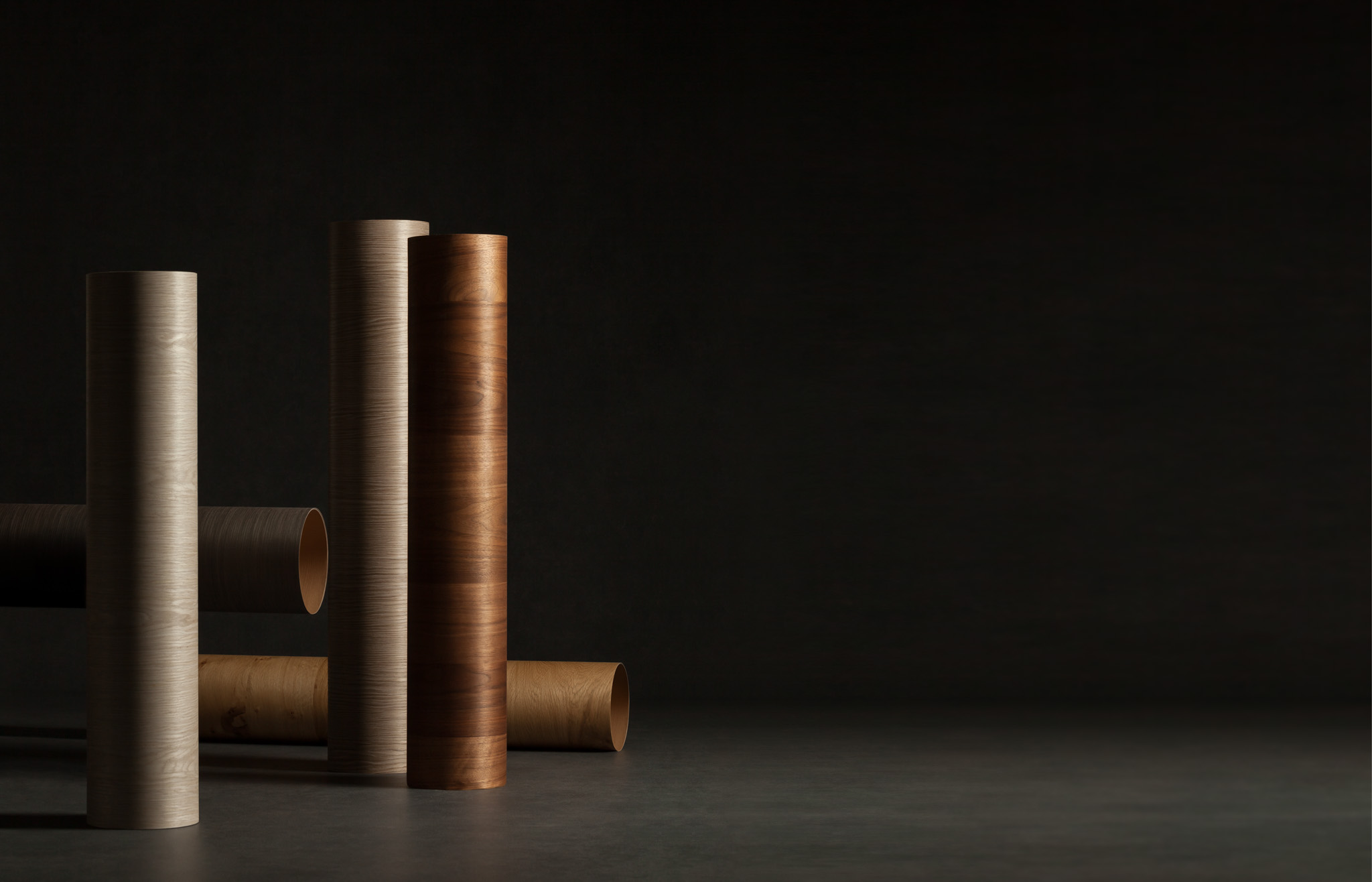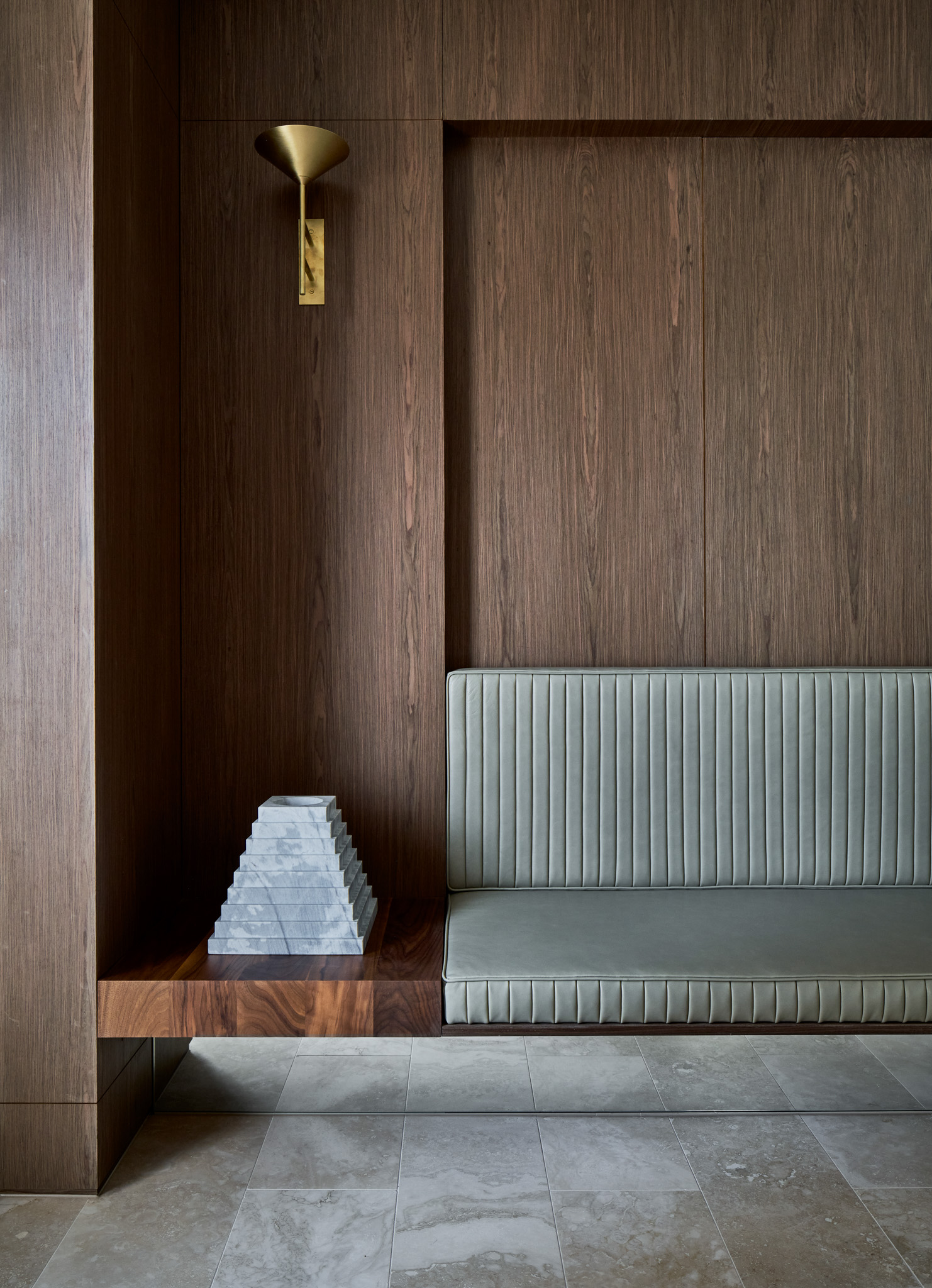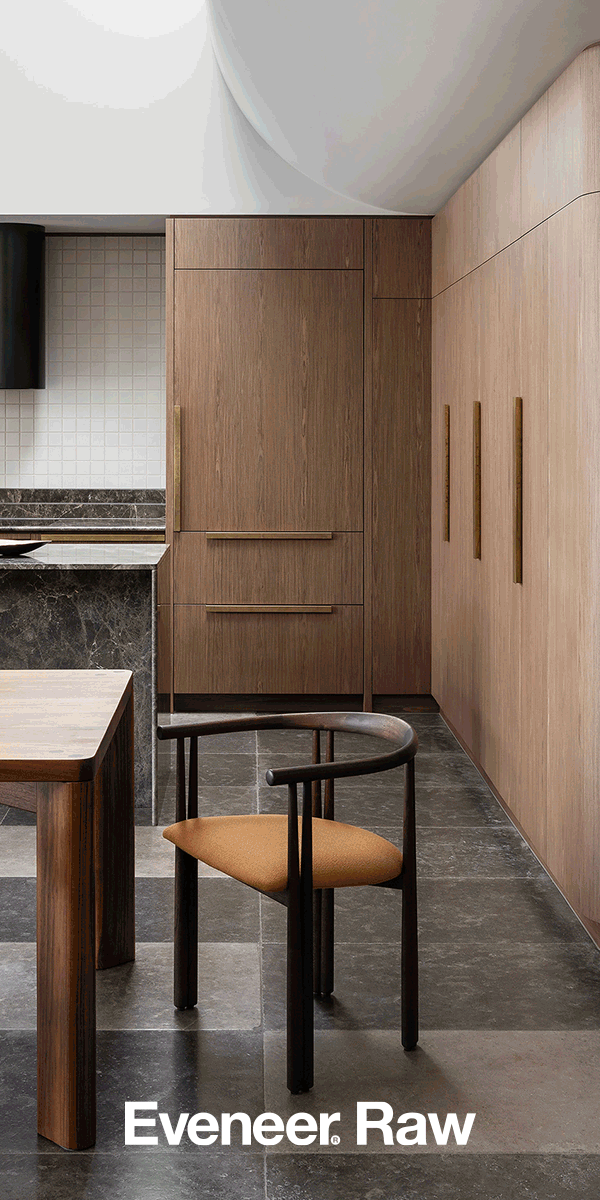A positive review of Rory Gardiner's photographic exhibition showcasing a project by the Melbourne-based architects, Baracco + Wright.
Elton Group's Surface Attention
Elton Group celebrates sustainable practice, fresh and diverse material expression and shares the promising future of timber veneer.
Essay
Olivia Sholler
Photography
Sophie Sideris, Timothy Kaye, Peter Clarke, Stefan Giftthaler

Eveneer WoodWall Timber Veneer Wallcovering. Photo: Sophie Sideris
We live in a time where the values of individuals and the wider community are being constantly redefined, with the need for more sustainable design materials now playing a significant role in this discourse. What once was considered waste is now an opportunity to recreate. Previously exploited natural resources are being reassessed for their extraction and application. More and more, we find ourselves asking: what else can these materials do and how else can we work with them?
The timeless wonder of timber, with its natural beauty and accessibility, has consistently established the material as a favourite among architects and designers. However, the trees from which this material originate play a crucial role in the worsening climate crisis. It is vital that we recognise the value of trees not only for their aesthetic and structural qualities, but also for their pivotal function in carbon capture and the preservation of biodiversity in our rapidly warming climate. We must also remain conscious of their extensive cultural significance, particularly among Aboriginal and Torres Strait Islander peoples and communities. Ethical practices and forestry regulations have supported a sustainable approach to working with wood, but timber veneer pushes the sustainability cause even further. Like peeling or slicing an apple, timber veneer is the product of finely peeling layers around, or slicing through, a tree to extract a greater yield of material. Extracting more material from fewer resources expands the use of the material and ensures greater value.

Melbourne-based and family-run timber veneer specialists Elton Group have worked at the intersection of timber and design since 1943 and have produced and distributed timber veneers for over 50 years. What started as a family member’s intrigue in the global materials space – via sourcing trips to Asia, Europe and the US – quickly turned into a successful import business that responded to the demands of the time. “The 1970s and 1980s were really big decades for timber veneer with a boom in fit outs for commercial offices, banks and hotels. Timber veneer was a status symbol used wall-to-wall for people’s dining suites, entertainment centres and bookcases. Most furniture back then was timber and made in Australia, ” explains Elton Group Director Karen Elton. She describes Elton Group as a matter of right time, right place with the company holding true to its interest in, and values of, offering quality design solutions with local relevance.
The irony in this period of excess between the 1970s and 1980s, of course, lies in the mounting environmental concerns at the time. In 1969, NATO established the Committee on the Challenges of Modern Society – the first international committee addressing environmental issues around
air pollution and the disposal of hazardous waste. The Land art movement of the time – also known as the Earth art movement – similarly offered an artistic expression of environmental activism, seeing artworks like Robert Smithson’s Spiral Jetty (1970) in the US, and Christo and Jeanne-Claude’s Wrapped Coast, One Million Square Feet (1968–1969) in Sydney’s Little Bay, on Bidjigal and Gadigal Country, come to life. As the tree grows and renews, its environmental value undergoes consistent transformation, ultimately positioning the timber veneer derived from the source as a sustainable material. “Trees can be replanted, regenerate naturally, produce oxygen and absorb carbon while growing and retaining carbon in its final state. During its life, a tree gives so much back to nature. In its final form, it’s still useful and locks up carbon,” says Elton.
Designers and producers in the wood space today must consider sustainability stipulations outlined by regulatory bodies such as the Forest Stewardship Council (FSC). FSC seeks to guarantee zero deforestation, protect endangered plant and animal species located in certified logging areas, and promote respectful practice that ensures local communities are consulted and that cultural land rights are upheld by supply chains. Elton Group advocates for these regulations and continually seeks innovative ways to progress sustainability through new product development. “Our Eveneer Raw (ALPIlignum) timber veneers are first peeled before being reassembled into rectangular blocks and sliced to create veneers with less waste … [this is] more suited to modern furniture manufacturing methods. Our WoodWall timber wallcovering utilises proprietary technology that slices to achieve yields three times those of normal veneer and it uses forty-three times fewer trees than standard timber panelling,” Elton explains. This refined slicing approach sees Elton Group make the most of a variety of tree species including the native Australian Spotted Gum and Blackbutt.
Education is a significant focus for Elton Group in their efforts to convey what timber veneer can do and the ways in which it can be responsibly sourced and integrated into design. “We have produced a digital booklet about veneer with the most essential knowledge that we can provide a designer [including] where timber veneer is appropriate to use, certifications [needed], et cetera,” explains Elton Group Creative Design Manager Tanya Hillman.
The gentle undulations, warm tones and subtle grains of timber that characterise these veneers invoke an immediate sense of grounding and calm within a space. One can trace the labyrinth of lines visible on the surface of a wooden cabinet and lose themselves in its pure, organic form. There is something to be said for being encased in this natural material; its healing properties far surpass any other. Indeed, wood has even been used to support healthcare and recovery for rehab patients, as shown by Herzog & de Meuron’s REHAB Basel Rehabilitation Centre in Switzerland. This rehab centre intentionally features wood throughout its design and construction to spur patient wellbeing. Alvar Aalto, master designer of the material, similarly placed his iconic wooden furniture pieces in the Paimio Sanatorium in Finland. As the world around us becomes increasingly digital, tangible materials – particularly those sourced directly from nature – can provide an essential anchor in our lives.

Timber veneer is not only used for covering wall and floor surfaces. It can also be integrated into furniture and object design, allowing for a freedom of aesthetic expression, attainable pricing, strength and most importantly, sustainability. Always looking for opportunities to share timber veneer’s potential, Elton Group have collaborated with a number of Australian designers including Broached Commissions and their showcase Broached Recall, exhibited as part of 2021 Melbourne Design Week. For this showcase, the creative agency had full access to Elton Group’s contemporary range and vintage veneers – some dating back to 1930 – with resulting works of refined geometric form harking back to a playful yet controlled Wiener Werkstätte and Josef Hoffmann design era.
Washes of colour are seen in the iconic Italian Alpi veneers that Elton Group distribute throughout Australasia. This collection consists of collaborations with international designers such as Ettore Sottsass, Patricia Urquiola, Martino Gamper and Kengo Kuma. The current MECCA X NGV Women in Design Commission sees UK designer and colour alchemist Bethan Laura Wood work with custom Alpi veneers across furniture pieces, further showcasing the creative potential and expressiveness of the material.
We often begin to value an item when it becomes scarce; we always want more of what we can’t have and we yearn for access to things before they disappear. As natural materials grow ever more limited, yet their aesthetic appeal endures, timber veneer offers a chance for extended collaboration and stewardship of design with an emphasis on sustainability.
eltongroup.com

Eveneer Raw Even Walnut featured in Boutique Office by Studio May. Photo: Peter Clarke

Eveneer Raw Even Walnut featured in Rose Park House by studiogram. Photo: Timothy Kaye

